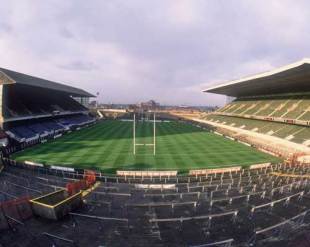|
1909
Ireland and France rack up a century
Huw Richards
February 6, 2009

Lansdowne Road in Dublin played host to the first ever clash between Ireland and France in 1909
© Getty Images
Enlarge
Few periods in the game's development have been quite so momentous as the years from 1905 to 1910. This saw the first tours of Britain by the All Blacks, Springboks and Wallabies, the Australian game's league-union schism of 1908, the opening of Twickenham and the progressive arrival by stages from 1906 of France, who had acquired a full set of fixtures in what now became the Five Nations Championship, by 1910. The consequence now is a magnificent run of centenaries. Saturday's meeting between Ireland and France at Croke Park, a possibility scarcely to have been entertained in 1989 let alone 1909, will mark the 100th anniversary of their first meeting. Ireland were the third of the home nations to admit the French, following England in 1906 and Wales two years later with Scotland, true to their reputation for conservatism bringing up the rear in 1910. It was played at Lansdowne Road on March 20, 1909. Ireland had already lost its other three matches, while France were traumatised by a 47-5 beating from Wales, still enjoying their first golden age, at the Stade Colombes. Pioneer Frantz Reichel recalled it as 'a match that spared no humiliation'. Like all early French teams - this was only the 8th international in their history - a squad containing six new caps travelled in hope rather than expectation. Their narrowest defeat in their previous seven matches had been a 19-0 loss to England a year earlier. They were tired before they got to Dublin, some players journeys by a variety of modes of transport taking as much as five days. Even so, the French produced their best performance yet, going down 19-8 in what veteran Irish wing Harry Thrift remembered as 'a light-hearted affair'. It was the last of Thrift's 18 matches for Ireland. He left along with two other stalwarts, tennis playing centre James Parke (20 caps, featured in the last column), and Fred Gardiner (22), a back rower who in Bergamascoesque style had played scrum-half against Scotland three weeks earlier. It was far, though, from being Thrift's last involvement in the game. He went on to a chair at Trinity College, Dublin and long career in officialdom culminating in 25 years as an International Board delegate, the last 23 (1933-56) as its secretary.
Gardiner captained the team, scored a try and landed a conversion while Belfast Collegians centre Charles Thompson scored Ireland's first and last tries while the other was contributed in his only international by Garryowen scrum-half John O'Connor. France's scores came from wing Gaston Lane and debutant back-rower Augustin Hourdebaigt. Lane was, along with captain Marcel Communeau, one of two survivors from the first ever France team, which had played against the first All Blacks on New Year's Day 1906. An engineer remembered by writer Charles Goudouin as 'an incomparable defender', he was also one of five members of this XV who survived to play in France's first ever winning team, against Scotland in 1911. Hourdebaigt was the only player from the south-west in a team containing 12 based in Paris, five from Stade Francais and six from Racing Club. Since his club Stade Bordelais were to be French champions in 1909, part of a run of seven titles in eight seasons, and their opponents in the first all-provincial final were Toulouse it is hard to escape the conclusion that as well as being handicapped by inexperience and lack of physical presence - there were few men of six feet or more in pre-1950 France - France's early results were also in part attributable to favouring the fashionable Parisian clubs over more effective provincials during this period. His international career lasted only a year but among the other debutants both Racing Club centre Marcel Burgun and second row Marcel Legrain were still in France's team in 1914. The outbreak of war was to cut short more than their careers. Both died in action, as would Lane and Pierre Guillemin who played hooker at Lansdowne Road in spite of being one of France's tallest forwards and its No.8 for the whole of the following year's championship campaign. Ireland was to win the first five, pre-war meetings between the two. France broke its duck at the Colombes in 1920 and has since taken revenge for those early defeats so comprehensively that this fixture is now historically the least equal of the tournament's 10 traditional fixtures, with France leading by 48 wins to 27 in championship clashes. Recent results in particular, with an inability to beat France the sole reason why the last few years have not been the best in Irish history, may make this a centenary that Ireland does not celebrate too enthusiastically. © Scrum.com
| |||||||||||||||
Live Sports
Communication error please reload the page.
-
Football
-
Cricket
-
Rugby
-
- Days
- Hrs
- Mins
- Secs
F1 - Abu Dhabi GP
Abu Dhabi Grand Prix December 11-131. Max Verstappen ()
2. Valtteri Bottas (Mercedes)
3. Lewis Hamilton (Mercedes)
4. Alexander Albon ()
5. Lando Norris ()
6. Carlos Sainz Jr ()
-
ESPNOtherLive >>
Darts - Premier League
Golf - Houston Open
Snooker - China Open
Tennis - Miami Open

